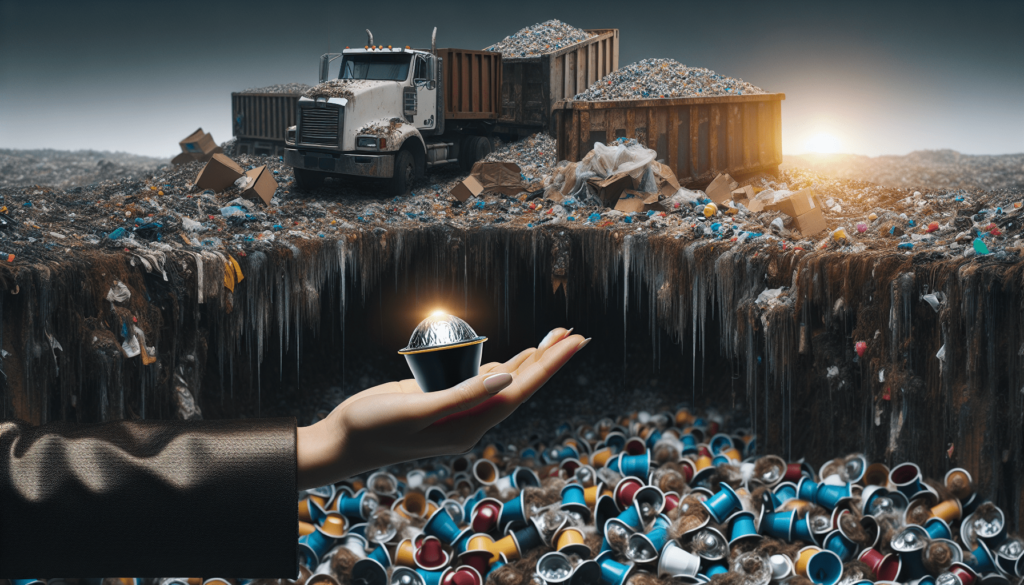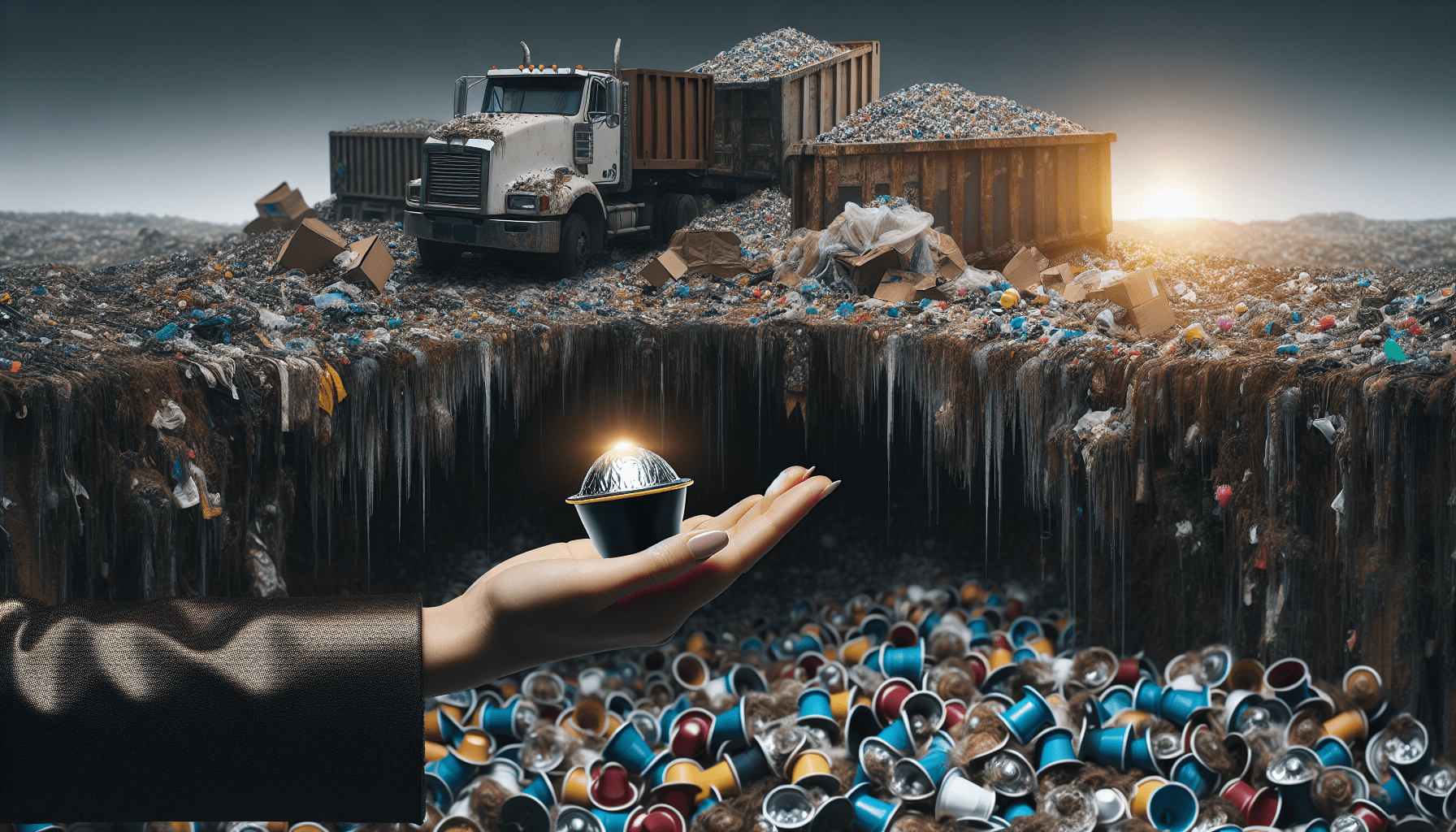Did you know that your morning cup of coffee could be contributing to environmental degradation? In recent years, single-use coffee pods have gained popularity as a convenient and quick way to brew coffee. However, their convenience comes at a cost. These tiny pods, made from a combination of plastic and aluminum, often end up in landfills and take hundreds of years to break down. As the demand for single-use coffee pods continues to rise, it is crucial to understand the detrimental environmental impact they have and explore alternative methods of brewing coffee that are more sustainable.

Overview of Single-Use Coffee Pods
Definition of single-use coffee pods
Single-use coffee pods, also known as coffee capsules, are small, pre-packaged containers filled with coffee grounds that are designed to brew a single cup of coffee. These pods are used with specific coffee machines that are designed to pierce the pod and extract the coffee. Single-use coffee pods have gained significant popularity in recent years due to their convenience and ease of use.
Types of single-use coffee pods
There are various types of single-use coffee pods available on the market. The most common types are plastic pods, aluminum pods, and compostable and biodegradable pods. Plastic pods are typically made from a combination of plastic and foil, while aluminum pods are made entirely from aluminum. Compostable and biodegradable pods, on the other hand, are designed to break down naturally in compost or landfill conditions.
Popularity and market growth of single-use coffee pods
Single-use coffee pods have experienced exponential growth in popularity over the past decade. This is largely due to their convenience and time-saving aspect, as they provide a quick and easy way to make a cup of coffee. The market for single-use coffee pods has expanded significantly, with a wide range of brands and flavors now available. With busy lifestyles becoming the norm, these pods have become a popular choice for coffee lovers worldwide.
Materials Used in Single-Use Coffee Pods
Plastic pods
Plastic pods are the most commonly used type of single-use coffee pods. These pods are typically made from a combination of plastic and aluminum foil, which is necessary to keep the coffee fresh. However, the use of plastic in these pods has raised concerns about their environmental impact. Plastic takes hundreds of years to decompose, and when discarded, it can end up in landfills or oceans, contributing to pollution and endangering wildlife.
Aluminum pods
Aluminum pods, which are made entirely from aluminum, have gained popularity as a more sustainable alternative to plastic pods. Aluminum is a highly recyclable material, meaning that these pods can be recycled and given a new life. However, it is important to note that not all recycling facilities accept aluminum coffee pods. This lack of accessibility to recycling options can limit the environmental benefit of aluminum pods.
Compostable and biodegradable pods
Compostable and biodegradable pods are designed to break down naturally and return to the environment without causing harm. These pods are typically made from sustainable materials such as plant-based fibers or starches. When disposed of correctly, compostable and biodegradable pods can be processed in industrial composting facilities, where they break down into organic matter. However, it is crucial to ensure that these pods are disposed of in the appropriate waste streams to maximize their environmental benefits.
Energy Consumption and Waste Generation
Energy required for production
The production of single-use coffee pods, regardless of the material used, requires a significant amount of energy. From the manufacturing of the pods themselves to the packaging and transportation, energy consumption throughout the entire production process is a concern. The extraction and refinement of raw materials, such as plastic or aluminum, further contribute to the energy footprint of these pods.
Disposal and recycling challenges
One of the major challenges associated with single-use coffee pods is their disposal. Plastic pods often end up in landfills due to limited recycling options, while aluminum pods require specific recycling facilities for proper disposal. The lack of accessibility to recycling facilities for both types of pods contributes to the significant waste generation associated with these products.
Waste generation and landfill impact
The use of single-use coffee pods has led to a substantial increase in waste generation. Considering the immense popularity of these pods, the sheer volume of discarded pods adds to the already overflowing landfills. Plastic pods, in particular, take hundreds of years to decompose, contributing to the enduring waste problem in our environment. This not only impacts the visual aesthetics but also poses serious environmental concerns.
Greenhouse Gas Emissions
Greenhouse gas emissions during production
The production of single-use coffee pods contributes to greenhouse gas emissions, primarily through the extraction, refinement, and manufacturing processes. The extraction of raw materials, such as plastic or aluminum, requires energy-intensive processes that release carbon dioxide and other greenhouse gases into the atmosphere. Industrial manufacturing processes further contribute to emissions, as does the packaging and transportation of the final products.
Transportation emissions
The transportation of single-use coffee pods, from manufacturing facilities to distribution centers and ultimately to consumers, also generates greenhouse gas emissions. The transportation of these pods over long distances, often across countries or continents, increases the carbon footprint associated with their production. The reliance on fossil fuels for transportation further exacerbates the environmental impact.
Methane emissions from landfills
When single-use coffee pods end up in landfills, they decompose and release methane gas, a potent greenhouse gas that contributes to climate change. Methane is produced in anaerobic conditions, such as those found in landfills, and its release into the atmosphere adds to the overall greenhouse gas emissions. Proper recycling or composting of these pods can help mitigate this issue.

Water Usage and Pollution
Water consumption in production
The production of single-use coffee pods requires significant water usage throughout various stages of the manufacturing process. From the cultivation of coffee beans to the extraction and refinement of materials, water is essential. The extraction of raw materials, such as plastic or aluminum, often requires large amounts of water, contributing to water scarcity concerns in areas already experiencing water stress.
Water pollution from plastic pods
The use of plastic pods also leads to water pollution. When plastic pods end up in bodies of water, they break down into smaller particles known as microplastics. These microplastics can harm marine life and contaminate water sources. Furthermore, the production and disposal of plastic pods can contribute to the pollution of nearby water bodies through chemical runoff and improper waste management practices.
Impact on aquatic ecosystems
The environmental impact of single-use coffee pods extends beyond water pollution. The excessive use of water for production, coupled with potential pesticide use in coffee cultivation, can negatively affect aquatic ecosystems. Runoff from coffee plantations can carry harmful chemicals into nearby water sources, disrupting the delicate balance of aquatic ecosystems and endangering the flora and fauna that rely on them.
Deforestation and Habitat Destruction
Coffee cultivation and land requirements
The production of coffee, the primary ingredient in single-use coffee pods, often requires large areas of land for cultivation. This can lead to deforestation and habitat destruction, particularly in regions where coffee production is expanding rapidly. Clearing land for coffee plantations often involves the removal of native vegetation, displacing wildlife and compromising biodiversity.
Clearing land for coffee plantations
The expansion of coffee plantations to meet the demand for single-use coffee pods has contributed to deforestation in several parts of the world. Forests are cleared to make way for coffee crops, resulting in the loss of valuable ecosystem services, such as carbon sequestration and habitat for numerous plant and animal species. Deforestation not only contributes to climate change but also threatens the fragile balance of ecosystems.
Loss of biodiversity and wildlife habitats
The destruction of natural habitats for coffee cultivation has severe implications for biodiversity and wildlife. Native species that once thrived in these ecosystems can be displaced or face extinction due to the loss of their natural habitats. The conversion of land for coffee production disrupts the intricate relationships between species, leading to imbalances in ecosystems and the potential loss of valuable genetic resources.
Chemical Pollution and Toxicity
Chemicals used in pod production
The production of single-use coffee pods often involves the use of chemicals, such as pesticides, herbicides, and fungicides, during coffee cultivation. These chemicals can have detrimental effects on the environment, contaminating soil, water, and air. Improper handling and disposal of these chemicals can lead to their spread beyond the intended areas, posing risks to human health and causing ecological damage.
Leaching of harmful substances into coffee
There are concerns about the potential leaching of harmful substances from the pods into the brewed coffee. Plastic pods, in particular, may release chemicals such as bisphenol-A (BPA) or phthalates, which are known to have adverse health effects. When these chemicals come into contact with hot water during the brewing process, there is a possibility of them leaching into the final beverage.
Health risks and environmental contamination
The presence of harmful chemicals in single-use coffee pods poses health risks to both consumers and the environment. Ingesting coffee brewed from pods that contain toxic substances can have detrimental effects on human health, ranging from hormone disruption to reproductive issues. Improper disposal of used pods and the subsequent release of these chemicals into the environment further contributes to pollution and ecological harm.
Sustainable Alternatives
Reusable coffee pods
One of the most sustainable alternatives to single-use coffee pods is the use of reusable coffee pods. These pods are typically made from durable materials such as stainless steel or silicone and can be filled with coffee grounds of your choice. By investing in reusable coffee pods, you can significantly reduce the amount of waste generated from single-use pods while still enjoying the convenience of single-serving coffee.
Refillable coffee pods
Refillable coffee pods offer another eco-friendly option for coffee lovers. Similar to reusable pods, refillable pods are designed to be filled with your favorite coffee grounds. After use, these pods can be cleaned and refilled, eliminating the need for single-use options. Refillable coffee pods not only reduce waste but also allow you to experiment with different coffee blends and flavors.
Bulk coffee options
Choosing to buy coffee in bulk, whether it be whole beans or ground coffee, is another sustainable alternative to single-use coffee pods. By purchasing coffee in larger quantities, you can minimize packaging waste and reduce the overall environmental impact. Using a traditional coffee maker or a French press to brew your coffee eliminates the need for single-use pods altogether, promoting a more sustainable coffee-drinking experience.
Responsibility of Manufacturers and Consumers
Implementing sustainable practices
Manufacturers of single-use coffee pods have a responsibility to implement sustainable practices throughout their entire production process. This includes sourcing materials from sustainable suppliers, reducing energy consumption, and investing in recycling initiatives. By embracing sustainable practices, manufacturers can help to minimize the environmental impact of their products and contribute to a more sustainable coffee industry.
Promoting eco-friendly choices
Coffee consumers also have a role to play in reducing the environmental impact of single-use coffee pods. By opting for compostable or biodegradable pods when available, choosing reusable or refillable options, and supporting brands that prioritize sustainability, consumers can drive demand for eco-friendly choices. By making conscious purchasing decisions, individuals can contribute to a more sustainable coffee culture.
Consumer awareness and education
Increasing consumer awareness and education about the environmental impact of single-use coffee pods is crucial. By providing information about the sustainability of various pod options, consumers can make informed choices that align with their values and concerns. Industry stakeholders, including manufacturers, retailers, and environmental organizations, should work together to educate the public about the environmental implications and promote sustainable alternatives.
Conclusion
The use of single-use coffee pods has revolutionized the way we consume coffee, offering convenience and quick access to our favorite beverage. However, the convenience comes at a cost. The environmental impact of single-use coffee pods, from their production to disposal, raises serious concerns about the sustainability of this popular trend. It is clear that action is needed to address the issues surrounding energy consumption, waste generation, greenhouse gas emissions, water usage, deforestation, chemical pollution, and habitat destruction.
It is imperative that manufacturers take responsibility for implementing sustainable practices throughout the production process. From sourcing materials to packaging and transportation, every step should be guided by environmental considerations. Likewise, consumers have the power to drive demand for more sustainable choices. By embracing reusable and refillable coffee pod options and supporting brands that prioritize sustainability, individuals can make a significant impact on reducing the environmental footprint of their coffee consumption.
Balancing convenience and sustainability is key. As coffee lovers, we value the ease and speed provided by single-use coffee pods. However, it is crucial to prioritize the long-term health of our planet and make conscious choices that minimize harm. By exploring sustainable alternatives and raising awareness about the environmental impact of single-use coffee pods, we can enjoy our daily cup of coffee while ensuring a better future for generations to come.

